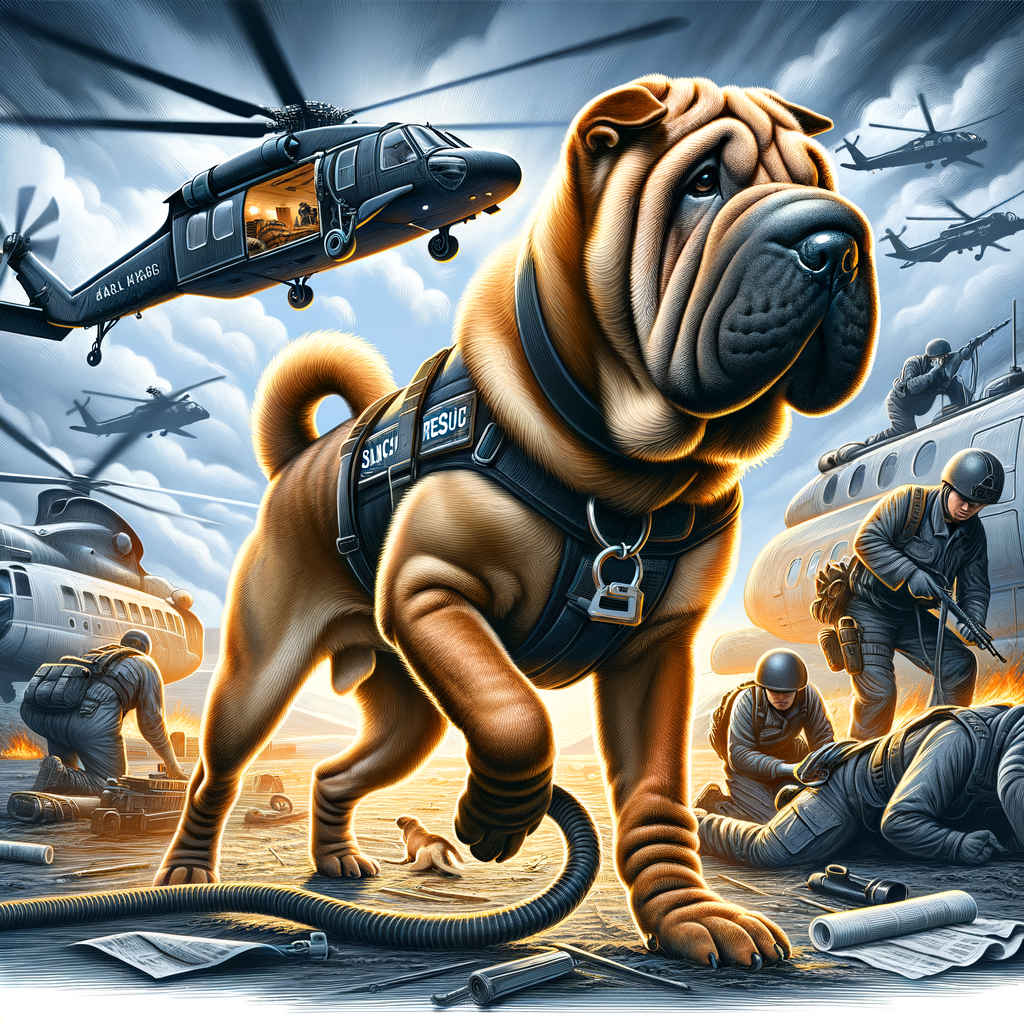
Introduction to Shar Pei as Working Dogs
Shar Peis are known for their distinctive appearance with deep wrinkles and a blue-black tongue. But there’s more to these dogs than just their unique looks. They are also recognized for their capabilities as working dogs. Let’s delve into an overview of their abilities and their historical roles in work settings.
- Overview of Shar Pei Capabilities
- Historical Roles of Shar Peis in Work Settings
Shar Peis are intelligent, versatile, and resilient dogs. They are known for their strength, agility, and endurance, which make them excellent working dogs. They have a keen sense of smell, which can be utilized in search and rescue operations. Their loyalty and protective nature also make them effective guard dogs.
Shar Peis are quick learners and can be trained to perform various tasks. They are also adaptable and can work in different environments, from urban areas to rural settings. Despite their somewhat aloof demeanor, they are highly focused when given a task, showcasing their dedication and commitment as working dogs.
Historically, Shar Peis were bred in China for various purposes. They were used as farm dogs, helping with herding livestock and protecting properties. Their strength and endurance were also utilized in hunting, as they were capable of tracking and catching game.
In more recent times, Shar Peis have been employed in different roles. They have been used in search and rescue operations, thanks to their keen sense of smell and ability to navigate difficult terrains. Some Shar Peis have also been trained as therapy dogs, providing comfort and companionship to people in hospitals, nursing homes, and other facilities.
Whether in historical or modern times, Shar Peis have proven their worth as working dogs. Their capabilities and adaptability make them suitable for various roles, showcasing their versatility and value in different work settings.
Search and Rescue Dogs: An Overview
Search and rescue dogs, often referred to as SAR dogs, play a crucial role in locating missing persons or objects in various environments. These dogs are trained to use their keen sense of smell and strong instincts to assist in rescue missions. Let’s delve into the role of these dogs and the key skills required in their training.
- Understanding the role of Search and Rescue Dogs
- Key skills required in Search and Rescue Dog Training
- Obedience: The dog must follow commands promptly and accurately. This is crucial for the safety of both the dog and the rescue team.
- Agility: The dog should be able to navigate through different terrains and obstacles. This includes climbing ladders, crawling through tunnels, and jumping over gaps.
- Scent Discrimination: The dog must be able to distinguish between different human scents. This is vital in situations where multiple people are missing.
- Endurance: SAR missions can be long and physically demanding. The dog must have the stamina to work for extended periods without getting tired.
Search and rescue dogs are a vital part of many rescue teams. They are trained to locate missing people in different situations, such as natural disasters, wilderness tracking, and even underwater searches. These dogs use their powerful sense of smell to detect human scent, even in the most challenging conditions.
For example, in the aftermath of an earthquake, SAR dogs can detect the scent of a person trapped under rubble, helping rescue teams locate survivors quickly. Similarly, in wilderness tracking, these dogs can pick up the scent of a lost hiker or camper and lead the team in the right direction.
Training a search and rescue dog requires patience, dedication, and a deep understanding of dog behavior. The key skills required in SAR dog training include:
Training a SAR dog is a long and rigorous process, often taking up to two years. However, the result is a highly skilled and invaluable member of any rescue team.
Shar Pei in Rescue Work: Is it Possible?
When we think of search and rescue dogs, breeds like the German Shepherd or the Labrador Retriever might come to mind. But what about the Shar Pei? Can this unique breed be trained for rescue work? Let’s explore this possibility.
Shar Pei Training for Search and Rescue
Training a Shar Pei for search and rescue work involves two main stages: mastering basic commands and advancing to specialized search and rescue skills.
- Training Shar Peis: Basic commands
- Advanced training: Shar Pei search and rescue skills
Before a Shar Pei can be trained for search and rescue work, it must first master basic commands. This includes commands like “sit,” “stay,” “come,” and “leave it.” These commands form the foundation for all future training and are essential for ensuring the dog’s safety during rescue operations.
Once a Shar Pei has mastered basic commands, it can move on to more advanced training. This includes learning to track scents, navigate difficult terrain, and locate missing persons. It’s important to note that this training is intense and requires a significant time commitment from both the dog and its handler. However, with patience and dedication, a Shar Pei can become a valuable asset in search and rescue operations.
In conclusion, while the Shar Pei may not be the first breed that comes to mind when we think of search and rescue dogs, it is certainly capable of performing this important work. With the right training and a committed handler, a Shar Pei can excel in search and rescue operations, providing a valuable service to communities in need.
Challenges in Training Shar Peis for Search and Rescue
Training a Shar Pei for search and rescue work is not without its challenges. There are two key areas that can pose difficulties: understanding the Shar Pei temperament and overcoming the physical limitations of the breed.
- Understanding the Shar Pei Temperament
- Physical Limitations of Shar Peis in Rescue Work
The Shar Pei is known for its independent and somewhat aloof nature. These dogs are intelligent, but they can also be stubborn, which can make training more difficult. They are not generally known for their eagerness to please, which is a trait often found in other breeds used in search and rescue work. However, with patience and consistent training methods, a Shar Pei can learn to follow commands and work effectively in a search and rescue team.
Shar Peis are medium-sized dogs with a compact, muscular build. While they are strong and agile, they do not have the endurance of some larger breeds often used in search and rescue work. Their unique skin folds can also trap heat, making them more susceptible to overheating in hot weather. This can limit their effectiveness in long search and rescue operations, particularly in warmer climates.
Despite these challenges, with the right training and care, a Shar Pei can become a valuable member of a search and rescue team. The key is to understand and work with the breed’s unique characteristics, rather than trying to train them in the same way as more traditional search and rescue breeds.
Case Studies: Shar Peis as Search and Rescue Heroes
Shar Peis are not just adorable pets. They can also be heroes. Let’s explore two real-life examples of Shar Peis who have made a significant difference in search and rescue operations.
-
Case Study 1: Shar Pei in a Local Rescue Operation
In a small town in Ohio, a Shar Pei named Max became a local hero. Max was part of a search and rescue team that was called in when a young boy named Timmy got lost in the woods. Max’s keen sense of smell and determination led the team directly to Timmy, who was found safe and sound.
Max’s story is a perfect example of how Shar Peis can be trained to become effective search and rescue dogs. Their strong sense of smell, combined with their natural tenacity, makes them excellent at tracking and finding lost individuals.
-
Case Study 2: Shar Pei in a National Rescue Operation
In another instance, a Shar Pei named Bella was involved in a national rescue operation after a devastating hurricane hit Florida. Bella was part of a team that was sent in to find survivors trapped in the rubble of collapsed buildings.
Bella’s sharp senses and agility helped locate several survivors who were then rescued by the team. Bella’s story highlights the potential of Shar Peis in large-scale rescue operations. Their ability to navigate through challenging terrains and their unwavering focus can be invaluable in such situations.
These case studies demonstrate the potential of Shar Peis as search and rescue dogs. With proper training and guidance, these dogs can become invaluable assets in rescue operations, saving lives and providing comfort in times of distress.
Key Takeaways: Shar Pei as Search and Rescue Dogs
As we conclude our exploration of Shar Peis as search and rescue dogs, let’s summarize the most important points. These key takeaways will help you understand the potential of these unique dogs in rescue work and the crucial role of proper training.
- The potential of Shar Peis in rescue work
- Importance of proper training for Shar Peis
Shar Peis, with their keen sense of smell and high intelligence, have the potential to excel in search and rescue work. They are known for their tenacity, loyalty, and determination, traits that are highly valued in rescue dogs. They are also sturdy and agile, capable of navigating challenging terrains that are often encountered in rescue situations. However, it’s important to remember that not all Shar Peis may be suited for this role. It depends on their individual temperament, physical abilities, and training.
Training is a critical factor in preparing Shar Peis for search and rescue work. These dogs need to be trained to follow commands promptly, work well with their handlers, and stay focused in high-stress situations. Training should start at a young age and be consistent, positive, and tailored to the dog’s unique needs and abilities. It’s also important to socialize Shar Peis early on to ensure they can work effectively in a team and interact well with people and other dogs.
In conclusion, while Shar Peis have the potential to be effective search and rescue dogs, their success in this role largely depends on their individual characteristics and the quality of their training. With the right approach, these dogs can make a significant contribution to rescue efforts and save lives.
Conclusion: The Future of Shar Peis in Search and Rescue
As we have seen throughout this article, Shar Peis have shown great potential in the field of search and rescue. Their keen sense of smell, combined with their intelligence and determination, make them excellent candidates for this type of work. But what does the future hold for Shar Peis in search and rescue? Let’s explore this further.
- Continued Training and Development of Shar Peis for Rescue Work
Training is a crucial part of a Shar Pei’s journey to becoming a search and rescue dog. This training needs to be continuous and rigorous to ensure that the dog is always ready for any situation. The future will likely see an increase in specialized training programs for Shar Peis, focusing on their unique skills and abilities. This will not only enhance their performance but also increase their chances of success in rescue operations.
- The Potential Impact of Shar Peis in Future Rescue Operations
With their unique set of skills, Shar Peis could significantly impact the future of rescue operations. Their ability to track scents and navigate difficult terrains can make a difference in life-threatening situations. As more Shar Peis are trained for this work, we can expect to see them playing a larger role in rescue operations around the world. Their contribution could potentially save countless lives and bring hope in times of despair.
In conclusion, the future of Shar Peis in search and rescue looks promising. With continued training and development, these dogs can make a significant impact in rescue operations. Their unique abilities make them a valuable asset in this field, and we look forward to seeing their contributions in the years to come.














